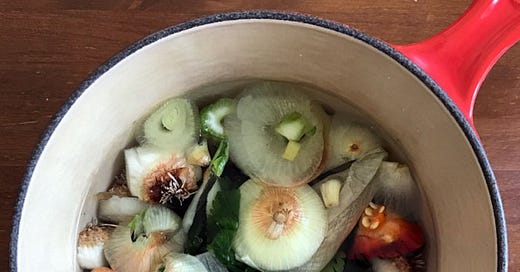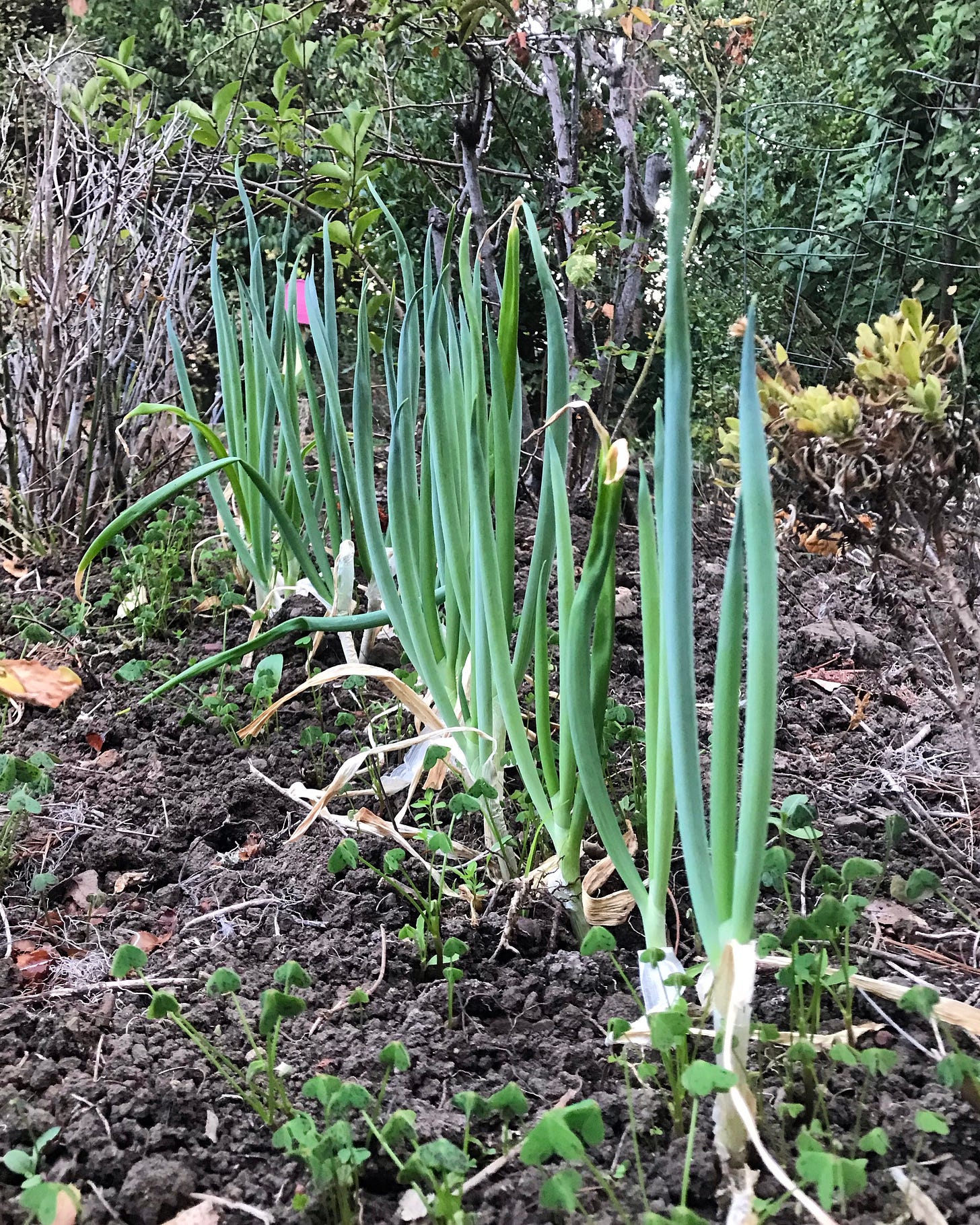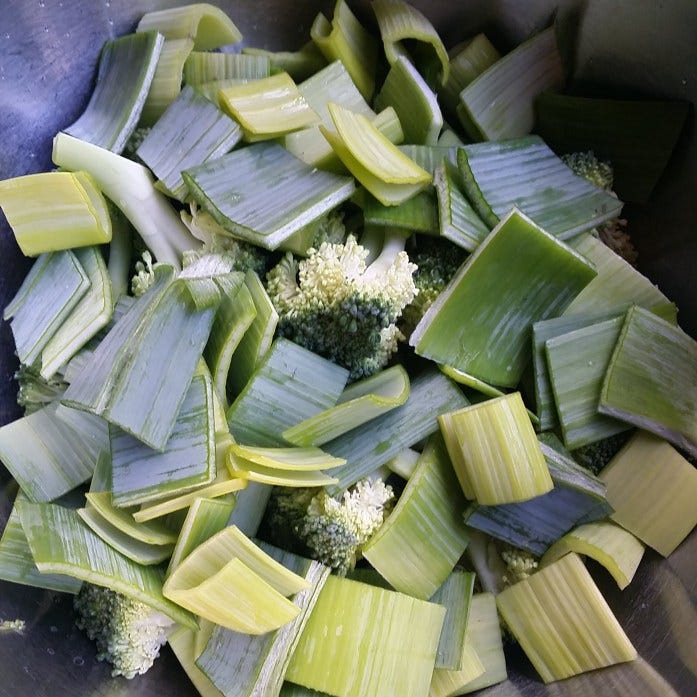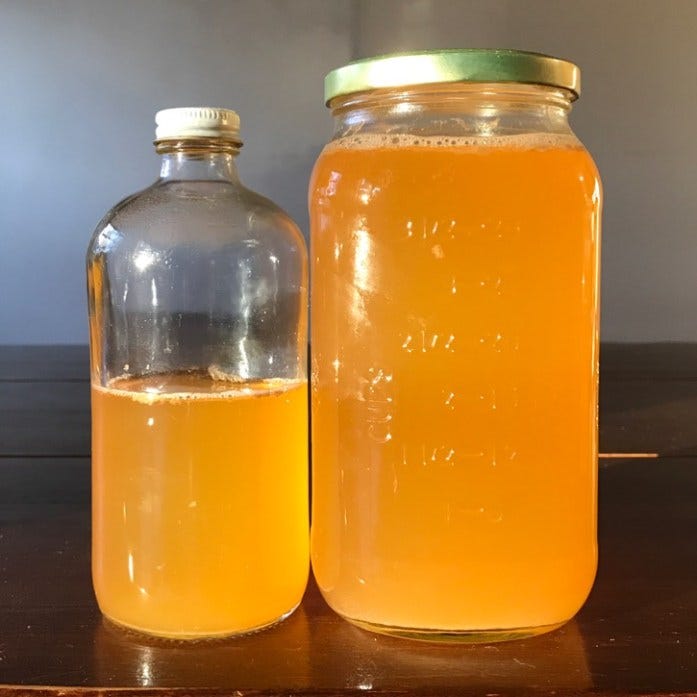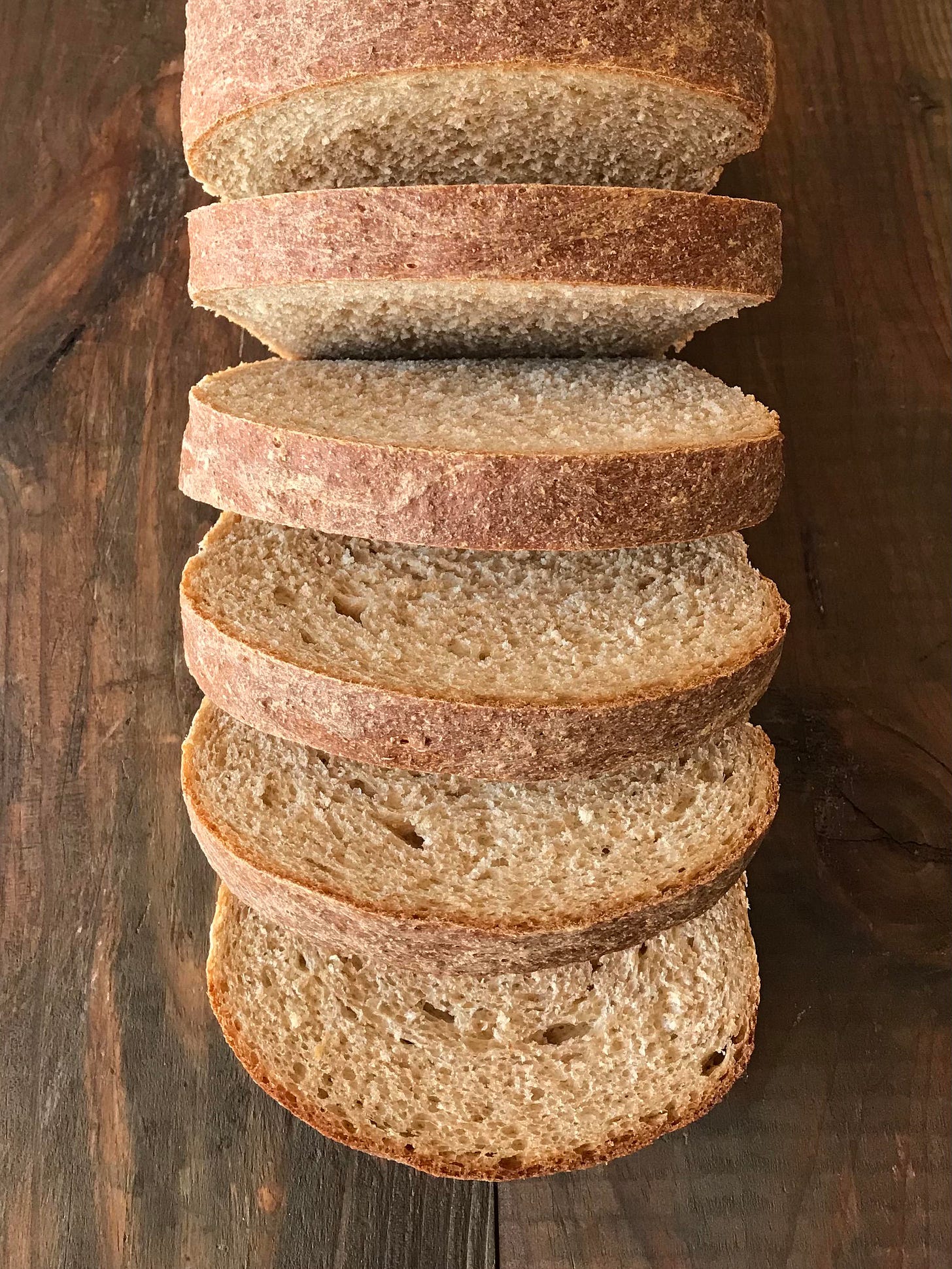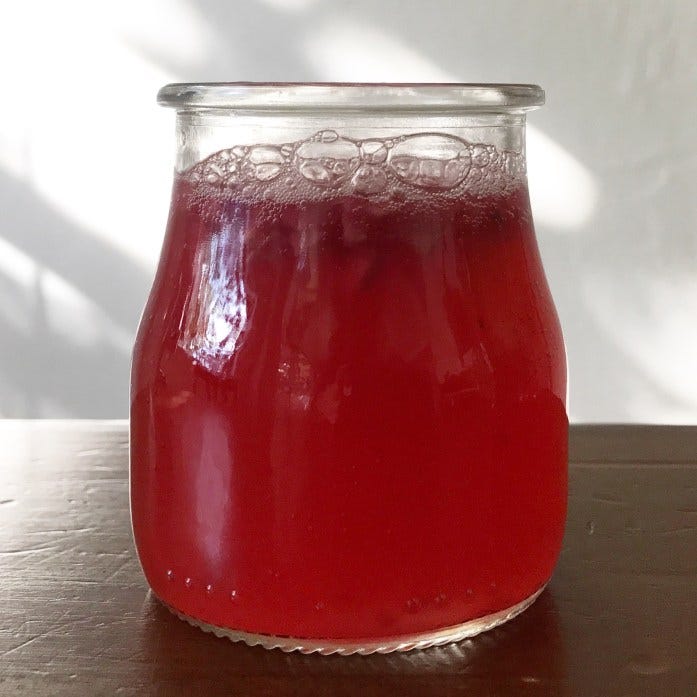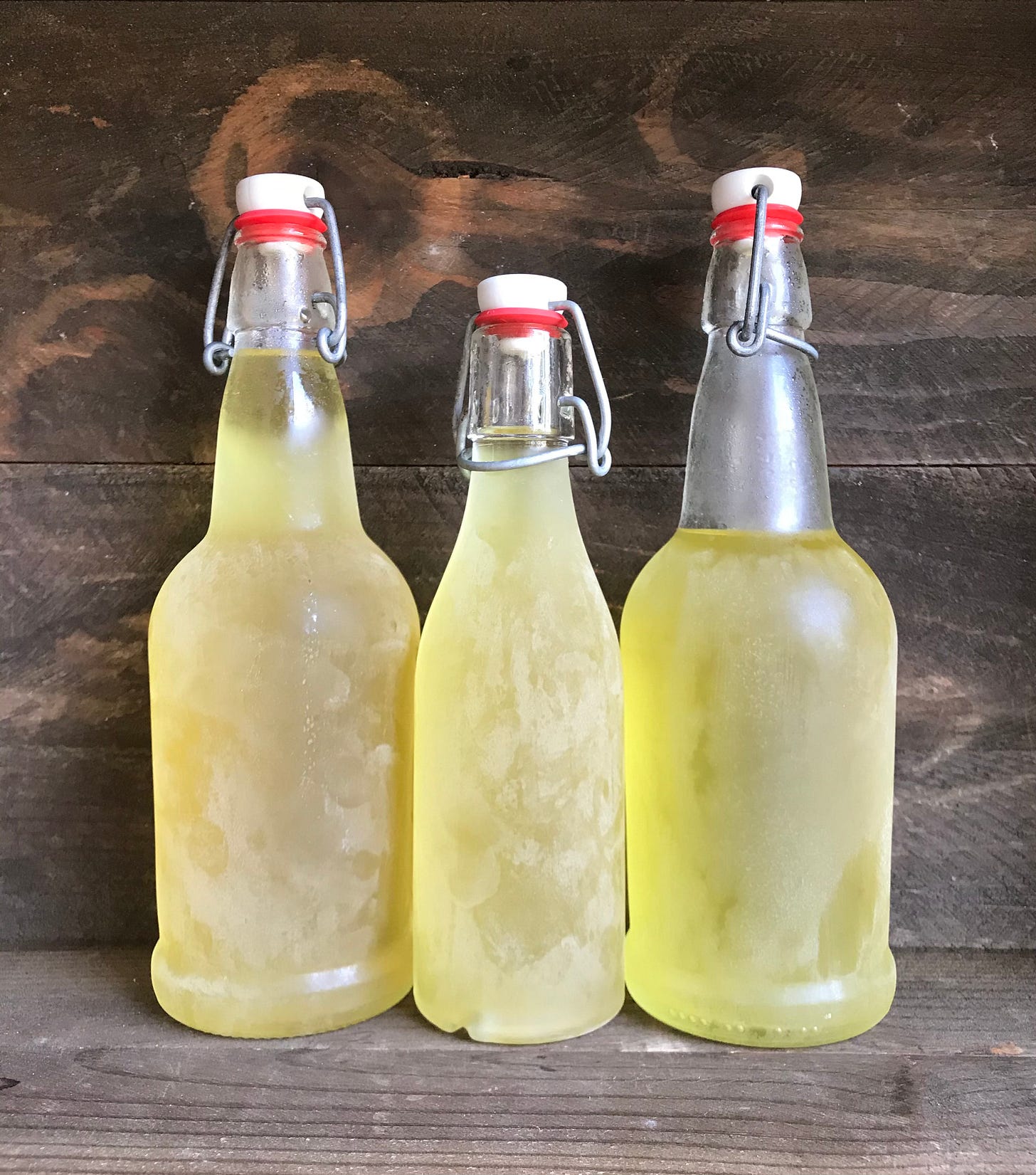Similar to our labeling less desirable plants as weeds, we deem many edible parts of vegetables as scraps, suitable only for the compost heap. But by thinking like Grandma and using every last bit of our food, we can elevate these scraps to their rightful designation in our kitchens: ingredients.
1. Various vegetable scraps
Vegetable broth was one of the first items we had to find a replacement for when we kicked the plastic. Even before we reduced our plastic, we cooked much of our food from scratch and that increased. When you cook this way, you accumulate lots of vegetable scraps—little bits of celery, the ends of onions, tomato cores, bell pepper bits, corn cobs and on and on. We started saving these bits to make broth.
Because it can take awhile to accumulate enough of these bits to make broth, I store them in the freezer until I have amassed a pile. I then simmer the bits in water for about 20 minutes. Here’s the full post on vegetable scrap broth. Go here for nine ways to cook with the broth.
Homemade scrap vegetable broth in the making
2. Green onion ends
You can easily regrow green onions. When prepping, reserve about one inch of the white ends with the roots, submerge those in water and after the green parts have regrown a bit, plant the onions in a pot of soil, either indoors or out, or plant directly in the soil outside. Basil also works well. Go here for a post on growing basil from cuttings.
Green onions regrown from ends
3. Kale stems
Some varieties of kale have an awful lot of stem on them. You can chop these hard stems up very finely and add them to soup or sneak them into other vegetable-forward dishes. Your family will never know. I made a stir fry earlier this week with both the stems and the leaves. I sautéed the chopped stems with the harder vegetables of my stir fry and threw in the leafy kale near the end of cooking. Delicious.
4. Potato skins
I buy organic potatoes. I avoid eating the skins of non-organic spuds. Sauté your skins in oil and sprinkle with salt and pepper or bake them. They taste fantastic. The skins will keep in the refrigerator after peeling but I find they have the best consistency if you fry them soon after peeling the potatoes. Click here for a full blog post on fried potato skins.
5. Leek tops
The green parts of leeks can easily constitute more than a third of the leek! Instead of tossing them, chop them into bite-size pieces and cook to render them tender. I often toss them in stir fry. You can also add them to soups, stews, sauces, frittata, quiche and many other dishes, use them instead of an onion in your favorite recipe or simply use the entire leek—white and green—in whatever recipe you’re making. Green potato-leek soup tastes fabulous.
These chopped leek tops went into a stir fry
6. Wilting carrots, zucchini or parsnips
Shred these up for quick bread, muffins, pancakes or your morning oatmeal. I use shredded vegetables to make fritters. Here is the recipe for those. You can also perk up your wilting vegetables simply by placing them in jars of water.
7. Fermented pickle brine
Pickles you find in the center aisles of grocery stores have been pasteurized. The ideas below apply to fermented pickles with live cultures—homemade or a brand like Bubbie’s, which you’ll find in the refrigerator section of the store.
After you gobble up your fermented dill pickles, save the brine. You can:
Drink it. At my farmers’ market, people pay about $5 a bottle for brine to drink. This probiotic drink is worth the money but you can get it free as a byproduct of your cultured dill pickles.
Use the brine to add some flavor to soup. Although the microbes die when heated, the brine adds flavor.
Liven up bland food. Made a batch of bland hummus? Add brine. A bit of brine also tastes delicious in potato salad.
Reserve a few tablespoons of the brine to kickstart the next batch of pickles or sauerkraut, fermented ketchup or chutney and so on.
8. Watermelon rinds
You could use your fermented brine from number 6 for these. Peel the rinds and stuff those rinds into a jar of brine. Or start these from scratch. Simply peel and cut up the rind into bite-size pieces, stuff into a jar, add salt, water and, if desired, spices (try dill and garlic) and let the jar sit for a few days. The naturally occurring bacteria on the watermelon will ferment the rinds into tangy “pickles.” When you like the flavor, move the rinds to the refrigerator. Click here for the full post on watermelon rind pickles.
9. Fruit scraps
I use fruit scraps to make scrap vinegar. I make apple scrap vinegar more than any other type but scraps from other fruit, such as pears or pineapples, also work. Fill a jar with the scraps, add a spoonful of sugar, pour in water just to cover, secure a lid or cloth, stir daily, wait and strain. The naturally occurring bacteria on the fruit will transform the fruity water to slightly alcoholic, then vinegary. At that point strain the vinegar and use it. Here is the full post on scrap vinegar.
A strong batch of apple scrap vinegar
10. Spent vanilla beans
If you make vanilla extract, save the spent vanilla pods when the extract is ready. Stuff the beans into a jar of granulated sugar, wait for at least a couple of weeks and you’ll have vanilla infused sugar. You can also dehydrate these pods and grind them up along with granulated sugar for super-fine vanilla sugar.
11. Parmesan rinds
Save cheese rinds and throw them into soup to add flavor. You can store them in a jar in the refrigerator or freezer until you’ll use them.
12. Whey from cheese making
I recently made paneer with milk that my daughter rescued from work. Although the best-before date had passed, the unopened milk had not gone south. Making paneer does render a shockingly large amount of whey however—which makes you think twice about eating lots of cheese and yogurt, as much of this whey goes to waste in food processing plants. But it doesn’t have to go to waste in your kitchen. Use the whey in place of water when you make bread such as this whole wheat sandwich bread.
Whole wheat bread made with leftovers: whey from making soft cheese and sourdough starter discard
13. Bread
We never waste bread. If we have stale bread on hand, we make French toast, croutons, bread crumbs and more. My cookbook includes a recipe for Mexican Hot Chocolate Bread Pudding. You’ll look forward to having stale bread on hand to make that.
14. Ginger bug bits
A ginger bug is a starter you make from ginger, sugar and water. A mature bug teems with good bacteria and yeast and you use the liquid in it to make fermented drinks like ginger beer and other natural sodas.
But if you keep a ginger bug (they are like pets), you must feed it fresh ginger and sugar regularly. Before you know it, you will have accumulated a pile of ginger. Don’t toss this! These ginger bits alone can ferment a drink such as sweetened hibiscus tea and transform it into bubbly goodness.
Here is the post on making a ginger bug. And here is another for hibiscus soda. In place of the liquid from the ginger bug, use about one tablespoon of ginger bits per 16-ounce bottle of sweetened tea.
Hibiscus soda fermented with ginger bits left over from a ginger bug starter
15. Citrus peels
These have so many uses. Make candied citrus peels or marmalade, blend with black tea and spices for chai, freeze the zest for baking, or soak in vinegar to make a household cleaner. Click here for more ideas to rescue citrus peels.
16. Limoncello
This use for citrus peels deserves its own entry.
When I recently prepared several jars of preserved lemons, before juicing additional lemons to top my jars stuffed with lemons, I peeled these lemons. I then submerged those peels in vodka for four weeks, strained them and added the infused alcohol to a simple sugar syrup. I store my finished limoncello in the freezer. Go here for the full, glorious limoncello recipe.
Homemade limoncello straight from the freezer
Are you a sourdough baker? I also have lots of ideas for your “discard”—the sourdough starter left over from feedings. Go here for 11 discard recipes.
If you ordered my book, first of all, thank you very much. I hope you are enjoying it. If you ordered it from Amazon, will you please write a review? Thank you for your support!

